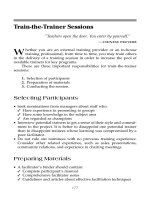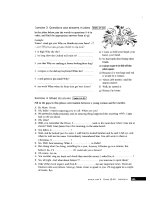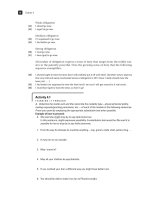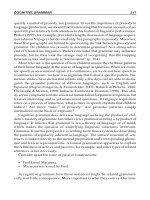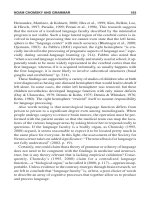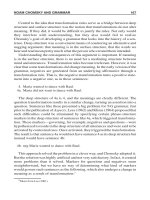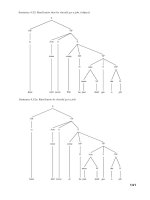The Teacher’s Grammar BookSecond Edition phần 5 ppt
Bạn đang xem bản rút gọn của tài liệu. Xem và tải ngay bản đầy đủ của tài liệu tại đây (727.3 KB, 37 trang )
ments: It places them in parentheses. With these factors in mind, we can adjust the
earlier rules so that they describe both sentences, as shown here:
S Æ NP VP
NP Æ (det) N
VP Æ V (NP)
det Æ art
N Æ Fred, suit
V Æ bought
art Æ a
This sentence grammar is more complex than the previous one because
we are writing a grammar that is generalizable to sentences 1 and 2, with the
exception of the individual words assigned. Now consider another, more
complex, example:
3. Maria wore an expensive evening gown.
This sentence is interesting because it adds adjectivals to our basic NP VP
combination, and one of them is a noun, evening. We therefore must adjust the
phrase-structure rules so that they will describe all three of our sentences,
which means adding a rule for the adjective phrase (AdjP) that describes both
types of adjectivals:
S Æ NP VP
NP Æ (det) (AdjP) N
VP Æ V (NP)
det Æ art
AdjP Æ
adj
NP
ì
í
î
ü
ý
þ
N Æ Maria, evening, gown
V Æ wore
104 CHAPTER 4
PHRASE STRUCTURE GRAMMAR 105
art Æ an
adj Æ expensive
The rule for AdjP introduces another convention—brackets. Brackets indi
-
cate that one of the elements, adj or NP, must be chosen.
Let’s take this opportunity to generalize a bit. The rule for AdjP describes all
adjectivals in a noun phrase, but it does not describe predicate adjectives, which
we discussed in chapter 3. The sentence, The tree was tall, illustrates a basic
sentence pattern, with tall functioning as a predicate adjective. Having dis
-
cussed adjectivals in the noun phrase, it is a good idea to extend our analysis
and adjust our rules here so that they will describe all instances of AdjP. We can
do this by making a simple modification to our rule for VP:
VP Æ V (NP) (AdjP)
Adjusting the rule for the verb phrase raises an interesting issue with respect
to verbs—the status of particles. We examined particles in chapter 3, but now
we can look at them more closely. While doing so, let’s consider another con-
struction that can appear in both the verb phrase and the noun phrase—the
prepositional phrase. Consider these sentences:
4. The goons with bow ties looked up the number for Pizza Hut.
5. Buggsy put the gun on the table.
The set of phrase-structure rules we have developed so far works to de-
scribe only parts of these sentences. Unlike sentences 1 through 3, sentence 4
has two prepositional phrases (PP) as parts of two noun phrases, and it has the
verb particle up (prt). Sentence 5 has a prepositional phrase as part of the verb
phrase. These structures were not in the previous example sentences, which
means that we must treat them as optional elements. Adjusting the rules
should be easy at this point: We must provide for optional prepositional
phrases in both NP and VP, and we must allow two possibilities for V, one be
-
ing a verb + particle combination. With these adjustments, we can describe
sentences 1 through 5 and many others:
S Æ NP VP
NP Æ (det) (AdjP) (PP) N
VP Æ V (NP) (AdjP) (PP)
AdjP Æ
adj
NP
ì
í
î
ü
ý
þ
PP Æ prep NP
V Æ
V
Vprt+
ì
í
î
ü
ý
þ
N Æ goons, bow ties, number, Pizza Hut, Buggsy, gun, table
V Æ looked + prt, put
det Æ the
prep Æ with, for, on
prt Æ up
These rules have value beyond their ability to describe sentences 1 through
5. They also help us understand that, as sentences become more complex, the
grammar must become more flexible if it is to describe a variety of structures.
NP and VP, for example, may have several elements, but they are all optional
except for the core features, N and V, respectively. Perhaps the larger goal of
phrase-structure grammar is becoming clear. Individual sentence grammars are
revealing, but the process of producing a new set of rules for all the possible in-
dividual sentences in English (an infinite number) is not practical. Moreover, it
does not provide a coherent picture of the whole language. The goal, therefore,
is to examine a wide range of sentences to develop a set of highly generalizable
statements that describe most (but not necessarily all) of the grammatical
sentences that speakers of the language normally produce.
APPLYING KEY IDEAS
Directions: Write separate phrase-structure rules for each of the following
sentences:
1. A bug danced across my palm.
2. The cold wind blew from the distant lake.
3. An old man asked for a drink at the bar.
4. Buggsy put on a coat and walked into the desert.
5.
Fritz really liked Macarena.
106 CHAPTER 4
PHRASE STRUCTURE GRAMMAR 107
TREE DIAGRAMS
Grammar is about sentences—the form of the words and their functions in sen
-
tences. Consequently, analyzing individual sentences is a major part of gram
-
matical study. Such analysis can provide a great deal of information about
language. In the 19
th
century, Alonzo Reed and Brainerd Kellogg developed a
way to diagram sentences in an effort to make grammatical analysis more re
-
vealing and meaningful. Many schools continue to use Reed-Kellogg diagrams
today, more than a hundred years later. As the examples that follow suggest, the
Reed-Kellogg approach to diagramming sentences gets very complicated very
quickly. These diagrams have no labels for constituents, so it is not easy to note
at a glance what the constituents are. Understanding the structure of any sen
-
tence demands understanding the structure of the diagramming procedure,
which is arbitrary and often counterintuitive.
Let’s consider three simple sentences:
6. Fred is a good friend.
7. Running is good exercise.
8. Buggsy believed that he was a handsome dog of a man.
Looking at sentences 6 and 7, we can see the counterintuitive nature of
Reed-Kellogg diagrams. Any analysis of a sentence must provide informa-
tion about form, but it also should describe clearly the relations of the vari-
ous components. The lack of labels in the Reed-Kellogg approach is a big
handicap in this regard. It forces Reed-Kellogg diagrams to adopt different
graphic structures for words that have identical functions but different
forms. All but exceptional students have a hard time figuring out how the
different graphic structures reflect their corresponding grammatical rela-
tions. In sentence 6, for example, Fred is a noun functioning as the subject,
Sentence 4.6: Fred is a good friend. (Reed-Kellogg diagram)
whereas in sentence 7, the subject Running is a gerund (a verb functioning
as a noun) functioning as a subject—but the diagrams are significantly dif-
ferent. We should expect subjects to have a similar diagrammatic structure
in every situation, but that isn’t the case with Reed-Kellogg diagrams. Sen-
tence 8 is seriously complex but grammatically it is very similar to sentence
6, which is really not evident from the diagrams.
A more revealing and instructional method of analysis is the tree diagram, in
which all the components are labeled and in which all the grammatical relations
are easily recognizable. Compare the tree diagrams on pages 110 and 111 with
their corresponding Reed-Kellogg diagrams. Notice how the labels and consis-
tent structureallow us to recognize theconstituents easily. The restof this chapter
contains quite a few diagrams and even more phrase structure rules. The aim is
not to introduce analyses simply for the sake of analysis but to aid in the under
-
standing of some of the more significant grammatical structures in English. The
diagrams and the rules allow deeper insight into the structure of language.
Direct and Indirect Objects
We examined direct and indirect objects in chapter 3 as part of the discus
-
sion of transitive and ditransitive verbs. Because the basic sentence pattern
in English is SVO, it is important to consider early on how phrase-structure
grammar treats objects. We already have a phrase-structure rule that de
-
scribes objects:
108 CHAPTER 4
Sentence 4.7: Running is good exercise. (Reed-Kellogg diagram)
109
Sentence 4.8: Buggsy believed that he was a handsome dog
of a man. (Reed-Kellogg diagram)
110
Sentence 4.6: Fred is a good friend. (Tree diagram)
Sentence 4.7: Running is good exercise. (Tree diagram)
PHRASE STRUCTURE GRAMMAR 111
VP Æ V (NP) (AdjP) (PP)
The only thing we have to keep in mind with these rules is that, for indirect
objects that appear as a noun phrase rather than as a prepositional phrase, we
add another noun phrase to the analysis. Consider this sentence:
9. Fritz sent his grandmother a gift.
This sentence has a verb phrase of the form V NP NP. The corresponding di
-
agram is on page 112.
Sentence 4.8: Buggsy believed that he was a handsome dog of a man. (Tree diagram)
Now consider sentence 10, which is an example of an indirect object in the
form of a prepositional phrase. Compare its associated diagram with the dia-
gram for sentence 9.
10. Buggsy asked a question of the commissioner.
112
Sentence 4.9: Fritz sent his grandmother a gift.
Sentence 4.10: Buggsy asked a question of the commissioner.
Prepositional Phrases
Prepositional phrases (PP) are interesting structures because they are so versa
-
tile. They can function as indirect objects, and they also can function as adver
-
bial modifiers and as adjectival modifiers. As adverbials, they can function as
sentence-level modifiers, which means that they can modify an entire clause. In
chapter 3, we discussed phrasal modifiers and noted that the prepositional
phrase is one of the major types. As indicated in that discussion, prepositional
phrases can appear in the initial, medial, or final positions. When they appear in
the initial positions, prepositional phrases are sentence-level modifiers. Sen
-
tences 11 through 15 illustrate the various positions and forms that preposi
-
tional phrases can take:
11. The goons put yellow flowers on the table. (adverbial)
12. Macarena, with a smile, accepted the invitation. (adverbial)
13. The woman with the red hair drives a Porsche. (adjectival)
14. In the morning, Buggsy went home. (sentence level, adverbial)
In addition, prepositional phrases can function as complements to certain
kinds of verbs, as in sentence 15:
15. Fred stepped onto the stool. (verb complement, adverbial)
Usage Note
Before the advent of printing, handwritten books were valued as much as
works of art as storehouses of information. They were beautifully illustrated,
and the monks who produced them took great pride in the quality of their callig-
raphy. Anyone who views some of these books in a museum will notice that the
calligraphy is so uniform as to rival mechanical printing. As literacy spread and
became more utilitarian during the 15
th
and 16
th
centuries, there arose a demand
for more readable and less expensive works. Punctuation emerged as a means
of making books more readable, as did a significant reduction in the amount of
artwork. Paragraphs, which were unknown in the ancient world, also became a
means of helping readers process texts.
The lesson we learn from this brief discussion is that punctuation is
largely a matter of convention rather than of rule. Indeed, different conven
-
tions govern punctuation in several contexts. Journalists, for example, fol
-
low the Associated Press convention when using commas with items in a
series and do not put a comma before the conjunction joining the last item;
PHRASE STRUCTURE GRAMMAR 113
those who follow the MLA and the APA conventions, on the other hand, do
put the comma before the conjunction.
With regard to prepositional phrases, there are two conventions governing
punctuation of phrases in the initial position. One holds that writers should use
length as the basis for deciding whether to set the modifier off with a comma. In
this convention, short structures are not set off, whereas long ones are. Al
-
though this approach is perfectly acceptable, it creates problems for teachers
whose students want as much consistency as possible.
Another convention holds that all modifying structures at the beginning of
sentences should be set off with a comma. Many teachers have adopted this
convention because it is easier to teach, or at least it is easier for students to ac
-
cept. They do not have to think about length.
Ambiguity
Language is inherently ambiguous, but certain prepositional phrase construc-
tions are quite obviously so. Under normal circumstances, we use context to
disambiguate such constructions, but it is possible to provide a grammatical
analysis that also disambiguates. Consider the following sentences:
16. Fred built the bench in the garage.
17. Macarena put the shoes in the box in the closet.
All ambiguous sentences have two possible meanings.
1
In sentence 16, one
meaning could be that the act of building the bench could have taken place in
the garage. The second meaning could be that the act of building could have oc-
curred anywhere other than the garage, but the bench is in the garage now. In
sentence 17, the shoes already could be in the box, and Macarena put those par
-
ticular boxed shoes in the closet. The other meaning could be that the empty
box already could be in the closet, and Macarena put the shoes in that box.
We can use grammatical analysis to disambiguate sentences like 16 and
17 because each possibility has a different phrase-structure, as illustrated in
the diagrams on pages 115 and 116.
COORDINATION
Coordination is one of the more common features of language, and phrase-
structure grammar provides a rule that is generally applicable to all coordinated
114 CHAPTER 4
1
Although the possibility exists for more than two meanings,examples are so rare that none could be
found for this text.
115
Sentence 4.16: Fred built the bench in the garage.
116
Sentence 4.17: Macarena put the shoes in the box in the closet.
structures. It is called the Coordinate XP rule, where X is a variable identifying
any element, such as noun or verb, and P is phrase. Coordinating conjunctions
are designated by CC. This rule supplies two pieces of information. First, any
phrase can be conjoined to another phrase of the same form. For example, any
two noun phrases can be linked using a coordinating conjunction. Second, the
two conjoined phrases function as asingle unit that has the character of the indi
-
vidual phrases. In other words, two noun phrases joined by a coordinating con
-
junction function as a single noun phrase. The rule is shown as:
XP Æ XP CC XP
We can see how the XP rule works in sentences 18 through 20. In 18, the sub
-
ject isFred and Fritz, which exists as a single unit and can be represented by XP.
But the subject consists of the two noun phrases: Fred and Fritz.
18. Fred and Fritz loved Cheerios.
The sentence grammar for 18 would be:
S Æ NP CC NP VP
NP Æ N
VP Æ V NP
Because language is inherently recursive, we can combine any number of
similar phrases in a single unit, as shown in sentence 19:
19. Macarena danced, laughed, and sang at the party.
We would describe the grammatical structure of 19 as follows:
S Æ NP VP
NP Æ (det) N
VP Æ VP VP CC VP PP
PP Æ prep NP
Compound Sentences
The Coordinate XP rule also applies to entire clauses, giving us a way of de
-
scribing the grammatical structure of compound sentences. A compound sen
-
tence is one that has two independent clauses. The analysis proceeds in
PHRASE STRUCTURE GRAMMAR 117
exactly the same way as we saw earlier, but rather than repeating phrases, the
rule repeats sentences.
Consider sentence 20:
20. A goon shot the ATM, so Buggsy made an easy withdrawal.
Because each clause has the structure of asentence, by convention our gram
-
mar would begin with:
S Æ S
1
CC S
2
What this means is simply that the sentence (S) consists of two clauses (S
1
and S
2
). The grammatical analysis for 20 then would proceed like those
shown earlier:
S
1
Æ NP VP
S
2
Æ NP VP
NP Æ (det) (AdjP) N
VP Æ V NP
AdjP Æ adj
Teaching Tip
Tree diagrams can help students better understand the nature of compound
sentences. If we diagram sentence 20, for example, the tree clearly shows
how the sentence is composed of two equal Ss, or clauses. When students
understand the structure of compounds, they more readily understand how to
punctuate them correctly.
118 CHAPTER 4
PHRASE STRUCTURE GRAMMAR 119
Sentence 20: A goon shot the ATM, so Buggsy made an easy withdrawal.
APPLYING KEY IDEAS
Directions: Draw tree diagrams for the following sentences. In the case of am
-
biguous sentences, disambiguate with two trees.
1. Macarena put the magazine on the table.
2. Fritz went to the races and bet on Lucky Lady.
3. Fred jogged to the boardwalk and watched the skaters.
4. Ophelia DiMarco and Raul drove to Rodeo Drive.
5. Fritz took the pictures with the camera in the den.
6. Macarena invited Fred for a swim, but he was busy.
7. Fritz sent roses to Macarena, and he bought her a lovely necklace.
8. Mrs. DiMarco baked a pie and a cake.
9. Without guilt or remorse, Buggsy enforced the contract.
10. Buggsy was on the road between Los Angeles and Las Vegas.
11. Raul cleaned the sofa in the living room.
12.
Macarena and Fritz danced until dawn at China Club.
Expanding the Verb Phrase
Our description of verb phrases to this point has been rudimentary. It has not in-
cluded any specification for tense, nor has it provided any means of describing
future or aspect. To describe these features, phrase-structure grammar expands
the analysis of the verb phrase.
Some minor changes to the phrase-structure rule for verb phrases are all that
are necessary. Currently, our rule for verb phrases looks like this:
VP Æ V (NP) (AdjP) (PP)
It designates NP, AdjP, and PP as optional elements of the VP.
To describe tense, we change the rule to include an auxiliary (Aux) constitu
-
ent that carries tense and other features to be discussed shortly:
VP Æ Aux V (NP) (AdjP) (PP)
Aux Æ tense
tense Æ
past
present
ì
í
î
ü
ý
þ
(As noted earlier, the brackets around past/present indicate that one of the
two must be chosen.)
120 CHAPTER 4
One of the beauties of phrase-structure grammar is its versatility. Earlier, we
modified our VP rule because we know that we have to be able to account for
tense if we are going to describe sentences accurately. But what about
adverbials? They are part of the VP, but so far we have not described grammati
-
cally how they appear in the language. Well, all we have to do is modify the VP
rule again by adding an optional adverbial phrase:
VP Æ Aux V (NP) (AdvP) (AdjP) (PP)
On page 79, we differentiated simple adverbs from adverbials, noting that
adverbs are single words and that adverbials are phrases and clauses—specifi
-
cally, prepositional phrases and subordinate clauses—that function adverbi
-
ally. Because phrase-structure rules do not provide explicit information about
function, prepositional phrases and subordinate clauses are not included under
the heading of AdjP. Consequently, if we expand the description of VP for
adverbs, we have:
AdvP Æ
adv
NP
ì
í
î
ü
ý
þ
This rule allows us to describe sentences like 21 and 22:
21. Quickly, she called her bank on the cell phone.
22. Macarena lost her checkbook yesterday.
Because adverbials and adjectivals frequently work together, we need one
more adjustment to the VP to describe sentences like 23:
23. Buggsy bought his wife a very expensive emerald necklace.
Again, making the change to the rule is quite simple:
AdjP Æ (AdvP)
adv
NP
ì
í
î
ü
ý
þ
At this point, the grammar rules are beginning to get more complicated, but
diagrams can help us visualize how the rules work to describe sentence gram
-
mar. Adiagram of sentence 23, for example, illustrates how the various compo
-
nents fit together.
PHRASE STRUCTURE GRAMMAR 121
Mood. Although we won’t examine this point in grammatical detail, verb
phrases include a feature of verbs known as mood. Mood indicates the
factuality or likelihood of the action or conditionality expressed by the verb,
and it also can express politeness. Mood is interesting, in part, because we com-
municate this information in verbs without even thinking about it.
There are three moods in English:
•
Indicative—used to state facts
Example: Buggsy owned the casino.
•
Imperative—used to express commands
Example: Stop the car!
•
Subjunctive—used to express matters contrary to fact, conditionality,
hypotheticals, wishes, and politeness in making requests
The first two moods are fairly concrete, but the subjunctive mood is subtle
and sometimes complicated because it applies under five different conditions.
Contrary-to-fact statements always and expressions of conditionality some
-
times require a dependent clause; this clause begins with the word if or
whether—depending on the nature of the statement, for the words are not syn
-
onymous in formal Standard English.
Also, the subjunctive verb form is interesting. In some cases, such as con
-
trary-to-fact statements, the verb form is in the past tense in the dependent as
122 CHAPTER 4
Sentence 4.23: Buggsy bought his wife a very expensive emerald necklace.
well as the independent clause. First- and third-person nouns and pronouns (I,
he, she) take the second-person verb form. The following examples illustrate
these unique features:
•
Subjunctive: Contrary-to-Fact Statements
1. If Fred were just a bit younger, he would apply for the position.
2. If I were you, I would leave town.
3. They acted as though Buggsy were watching.
•
Subjunctive: Conditional Statements
1. Fred will leave if Buggsy comes to the party.
2. After eating his veggies, little Johnny could have his dessert.
3. We will gain our reward, provided we be strong.
•
Subjunctive: Hypothetical Acts
1. If Fred bought the new BMW, he would be completely broke.
2. If he were asked, he would serve.
•
Subjunctive: Expressing a Wish
1. Macarena wished she were rich.
2. Fritz recommended that she be patient.
•
Subjunctive: Politeness in Requests
1. Would you open the window?
2. Could you close the door?
Usage Note
Linguists have noted a significant change in the use of the subjunctive in
contrary-to-fact statements involving forms of be. In spoken English, there has
been a shift in the verb form in the dependent clause to make it agree in number
with its noun or pronoun (although this shift is apparent only in sentences with
personal pronouns and names as subjects). As a result, the example sentences
just cited increasingly are expressed as:
• If Fred was just a bit younger, he would apply for the position.
• If I was you, I would leave town.
• They acted as though Buggsy was watching.
The subjunctive marker is dropped in the verb in the dependent clause, but it is
retained in the independent clause. Again, the question of what constitutes stan
-
dard usage is important. Some people argue that standard usage is whatever the
most people use. This argument is off the mark because it fails to take into account
the influences of prestige and acceptability that generally govern standard usage.
Thus, standard usage is not, and never hasbeen, the form used mostwidely; it is the
PHRASE STRUCTURE GRAMMAR 123
form mostwidely accepted. The subjunctive form is accepted by thosewho use for
-
mal StandardEnglish and by those who do not,whereas the nonsubjunctive form is
accepted only by those who use the nonstandard form. Standard usage of the sub
-
junctive, for example, continues to appear in a great deal of writing, with the nota
-
ble exception of popular journalism, as well as in the speech of many people.
Note that nonstandard usage does not differentiate between if and whether in
contrary-to-fact clauses. As a result, these sentences are deemed equivalent:
• ?I don’t know if it’s going to snow.
• I don’t know whether it’s going to snow.
Standard usage, however, does make a distinction. If is used to introduce
contrary-to-fact and conditional clauses, whereas whether is used to introduce
clauses that express, implicitly or explicitly, alternative possibilities. Because
there clearly are alternative possibilities to snow, the second sentence follows
standard usage conventions, but the first one does not.
Some observers have suggested that the subjunctive is disappearing with re-
spect to expressing politeness in making requests. The example requests cited
earlier may be more commonly expressed today as commands with a tag ques-
tion seeking agreement:
• Open the window, ok?
• Close the door, ok?
Identifying the causes for these changes must be a speculative endeavor, but
the loss of subjunctive in contrary-to-fact and conditional statements may be
related to a principle of behavioral efficiency. Generally, subjects and predi-
cates agree with respect to number. In a wide variety of situations, English fol-
lows a pattern of using a singular verb form with singular subjects and a plural
verb form with plural subjects, as in I was tired and They were late. The sub
-
junctive alters this pattern. The lack of agreement seems—and is—contrary to
the pattern that we find with most verbs. One therefore could argue that it is
more efficient to eliminate the distinction and use the singular pattern of
agreement in all situations.
With respect to the disappearance of the subjunctive to express politeness,
many contemporary social commentators have remarked on the significant de
-
crease in politeness in American society—or the increase in rudeness and out
-
right hostility, depending on one’s perspective—which might be a factor in the
shift from requests to commands. The decrease in politeness, in turn, is seen as
one reaction to the dramatic population increase that the United States has ex
-
124 CHAPTER 4
perienced during the last 30 years. As population becomes more dense, there is
greater competition for resources and thus more hostility. The hostility, in turn,
appears to be linked to the widely held view—which has erupted like the pox
during the last 30 years—that others have no rights and are undeserving of re
-
spect or consideration. Social commentators point to a variety of behaviors,
seldom observed a generation ago, as evidence for this assessment—the plague
of drivers who cut off others in traffic, run red lights, and generally act as
though they own the roads; the increase in littering that has piled rubbish ankle
deep in so many cities; and the general surliness of service providers who have
abandoned the traditional motto, “The Customer Is Always Right,” for the
unsavory alternative, “The Customer Is Always Wrong.”
Teaching Tip
Students have difficulty with the subjunctive for two reasons. First, they aren’t
used to hearing it, so the form doesn’t rest very firmly in their linguistic reper
-
toire. Second, the form does, indeed, represent an unusual pattern, for it is con-
trary to the usual agreement between subject and verb. These difficulties
require a systematic approach to instruction. One effective method is to begin
by describing the nature of the subjunctive, how it is used and why, with plenty
of examples. Then ask students to examine several paragraphs in their reading
assignments and find at least three sentences that use the subjunctive; they
should share these sentences with the class, explaining how the subjunctive is
used in each case. Finally, have them work in pairs or small groups to observe
conversations in the cafeteria, in other classes, or at the mall; the goal is to re-
cord any instances of the subjunctive in actual speech or any instances in
which the subjunctive should have been used but was not. Student teams
should share their findings with the class. What conclusions can they make on
the basis of their study of texts and their observations of conversations?
Modals
Some features of mood, such as hypothetical permission, are expressed in
words that are called modals (M). The modals are listed here:
will all
may must
can
Historically, English modals came from a special class of verbs in Ger
-
manic, the ancestor of English and the other Germanic languages. Modals have
always differed from ordinary verbs, to the point where they now belong to a
special category of their own. Modals and verbs differ in the range of forms that
PHRASE STRUCTURE GRAMMAR 125
they exhibit. English verbs appear in a number of distinct forms, whereas
modals have a single, invariant form. For instance, modals never end in -s, even
in sentences with third-person singular subjects.
To include the modal in our grammar, we simply expand the rule for auxil
-
iary to account for tense markers (past and present) and modals, as shown:
Aux Æ tense (M)
M Æ
will
shall
can
may
must
ì
í
ï
ï
ï
î
ï
ï
ï
ü
ý
ï
ï
ï
þ
ï
ï
ï
With this modification to our rules, we can describe sentences such as 24:
24. Fritz may get a promotion.
Analysis of this sentence is shown in the following tree diagram on the
next page.
A question that often arises in the analysis of expanded verb phrases is why
the tense marker is placed in front of the verb rather than after. The past parti-
ciple suffix -ed/-en, after all, comes at the end of a verb, not at the beginning.
The answer is that there is no simple way to capture schematically the rela-
tions among tense, modals, and verbs. Whenever a verb has a modal, the
modal is tensed, not the verb. If our description put tense after the verb, we
would solve nothing—we would still have the question of how tense jumps
over the verb and attaches to the modal. The placement of tense at the head of
the VP is a matter of convention; placing it elsewhere in the VP would not en
-
hance the description.
What we learn here is that structural analyses are at best an approximate de
-
scription of the language we actually use. Ifwe wanted to account forthe fact that
the past participle appears at the end of verbs, we would have to develop a special
126 CHAPTER 4
rule for attachment, which indeed is what linguists have done. Nevertheless,
structural analyses reveal much about the nature of grammatical constructions.
Tense and Its Complexities
When we examine tense closely, it becomes apparent that the relation between
tense and verbs is not a simple one. Tense does not merely indicate when an ac
-
tion took place, as evidenced in sentences such as Macarena could visit her sick
friend in the morning. The verb visit is not tensed in this sentence; instead, the
tense marker is attached to the modal. But although the modal is in the past
tense, the action is to occur in the future. Many students have a hard time grasp
-
ing this concept.
PHRASE STRUCTURE GRAMMAR 127
Sentence: 4.24: Fritz may get a promotion.
Usage Note
Although modals are function words, they nevertheless have a semantic
content. Can and may, for example, do not mean the same thing. Can indicates
ability, whereas may indicates permission as well as a conditional future. With
regard to requesting permission, popular usage has largely eliminated may and
replaced it with can. If a student wants permission to use the rest room, he or
she invariably will ask, Can I use the rest room rather than May I use the rest
room. In a department store, clerks will ask, Can I help you, not May I help you.
Formal standard usage, however, continues to differentiate between these
words, which makes helping students understand the difference a worthwhile
goal. Because may can signify two different meanings, it can lead to ambiguity.
Consider the following sentences:
25. Fritz can play the piano.
26. Fritz may play the piano.
Sentence 25 signifies Fritz’s ability to play; sentence 26 can be understood
as giving Fritz permission to play, or it can be understood as a comment about
Fritz’s playing the piano at some time in the future. The condition is uncertain.
We easily can imagine this future conditional if we think of Fritz being at a
party. Sentence 27 offers another example of may as a future conditional:
27. Buggsy may take a trip to Las Vegas next week.
It is worth noting that the past tense form of may is might. These words differ
in that might signifies a more uncertain or doubtful future than does may. Thus,
the likelihood of Buggsy taking a trip is more uncertain in sentence 28 than it is
in sentence 27:
28. Buggsy might take a trip to Las Vegas next week.
Like many other usage distinctions, this one seems to be disappearing. Even
speakers and writers of formal Standard English rarely differentiate the two
forms. However, anyone interested in using language as precisely as possible
will, indeed, differentiate them.
The difference between will and shall is far more complicated, and it, too,
has essentially disappeared in American usage. The traditional distinction
maintains that shall is used to indicate the simple future in the first person, as in
I shall go to the movies. Shall cannot be used in the second and third persons,
however, but instead must be replaced by will, as in They will end the strike
128 CHAPTER 4
